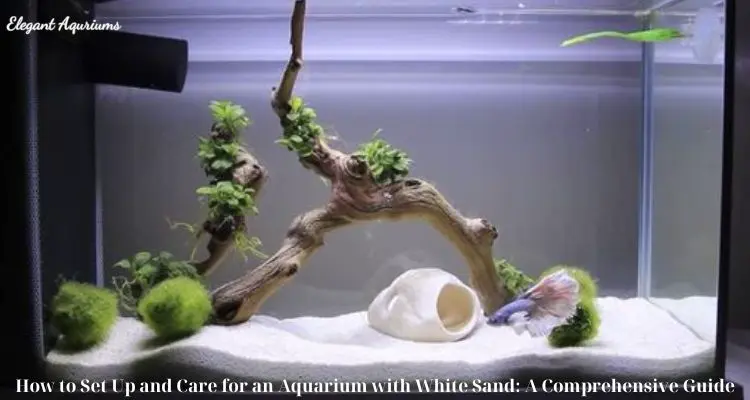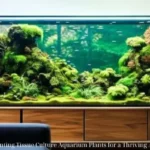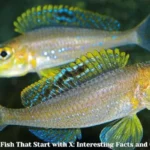Fish tank and equipment
How to Set Up and Care for an Aquarium with White Sand: A Comprehensive Guide
Setting up and maintaining an aquarium with white sand can be a visually stunning choice for any aquarium enthusiast. White sand substrates offer a clean, bright look that can enhance the beauty of your aquatic environment and provide a striking contrast to colorful fish and lush plants. Elegant Aquriums will walk you through the steps of setting up an aquarium with white sand, including tips for installation, maintenance, and care.
Benefits of Using White Sand
Before diving into the setup process, let’s explore the benefits of using white sand in your aquarium:
- Aesthetic Appeal: White sand creates a bright, clean, and modern look, enhancing the colors of your fish and plants. It mimics natural habitats like beaches and coral reefs, providing a beautiful backdrop for your aquatic life.
- Natural Environment: Many fish species come from sandy environments. Using white sand can provide a more natural and comfortable habitat for them, encouraging natural behaviors like digging and foraging.
- Reflective Properties: White sand reflects light well, which can enhance the lighting of your aquarium, making it appear brighter and more vibrant.
- Smooth Texture: The smooth texture of sand is gentle on the delicate barbels and skin of bottom-dwelling fish and invertebrates.
Choosing the Right White Sand

Types of White Sand
When selecting white sand for your aquarium, you have several options:
- Silica Sand: A common choice due to its natural appearance and ease of cleaning. It’s essential to choose sand that is specifically labeled as aquarium-safe to avoid any potential harm to your fish.
- Crushed Coral Sand: This sand is often used for saltwater aquariums and provides a natural buffering capacity to maintain stable pH levels. However, it may not be suitable for all freshwater setups.
- Aragonite Sand: Ideal for saltwater aquariums, aragonite sand helps to stabilize water chemistry. Its fine texture and light color make it a popular choice for marine tanks.
Factors to Consider
- Grain Size: Choose sand with a grain size that suits your aquarium’s inhabitants. Fine sand is excellent for delicate fish and shrimp, while coarser sand can be better for larger fish and bottom dwellers.
- Compatibility: Ensure the sand is compatible with your tank’s ecosystem, whether it’s a freshwater or saltwater setup. Some sands may affect water parameters, so check their suitability before purchasing.
Preparing Your Aquarium for White Sand
Cleaning the Aquarium
Before adding any substrate, ensure your aquarium is thoroughly cleaned:
- Empty the Tank: Remove any existing substrate, decorations, and equipment. Clean the tank with an aquarium-safe cleaner and rinse thoroughly to remove any residues or contaminants.
- Inspect Equipment: Check your filter, heater, and other equipment for wear and tear. Make any necessary repairs or replacements before proceeding with the setup.
Installing Equipment
- Filter Placement: Position the filter to ensure effective water circulation. Avoid placing the intake in a way that could get clogged by the sand. If using a hang-on-back filter, ensure it is properly installed above the sand level.
- Heater Setup: Install the heater in a location with good water flow but away from direct contact with the sand to prevent overheating and sediment buildup.
- Lighting: Set up your aquarium lighting according to the needs of your plants and fish. White sand reflects light well, so consider the impact of lighting on the overall appearance of your tank.
Adding White Sand to Your Aquarium
Rinsing the Sand
Properly rinsing the white sand is essential to prevent cloudiness and ensure a clean setup:
- Rinsing Process: Place the sand in a large container or bucket. Rinse it thoroughly with water, stirring occasionally until the water runs clear. This step removes dust and fine particles that can cloud the water.
- Avoiding Cloudiness: To minimize cloudiness when adding sand to the tank, use a plate or bowl placed on top of the sand. Pour water gently over the plate to prevent disturbing the sand and creating a murky tank.
Adding the Sand
- Layer Thickness: Pour the rinsed sand into the aquarium, aiming for a depth of 1-2 inches. This depth is usually sufficient for most setups and allows for effective filtration and plant rooting.
- Even Distribution: Spread the sand evenly across the tank’s bottom. Use a leveler or your hand to smooth out the sand and ensure an even layer. Avoid creating slopes or uneven surfaces that could affect water flow and stability.
Setting Up Your Aquarium with White Sand
Installing Equipment
- Filter Setup: Ensure the filter is properly positioned to avoid clogging and maintain efficient water flow. The filter should provide adequate circulation without disrupting the sand.
- Heater Positioning: Place the heater in a location with good circulation but away from the sand to prevent potential issues with overheating or sediment accumulation.
- Lighting Configuration: Arrange the lighting to enhance the beauty of the white sand and ensure adequate light for any live plants. Consider using a light with adjustable intensity to accommodate different tank setups.
Adding Decorations and Plants
- Decorations: Introduce decorations such as rocks, driftwood, or artificial structures. Position them carefully to create an aesthetically pleasing layout and avoid obstructing water flow.
- Planting: If adding live plants, choose species that thrive in your tank’s conditions. Plant them securely in the sand, ensuring their roots are well-anchored. Consider using plant weights or root tabs to help stabilize the plants.
4.3 Filling the Tank
- Water Addition: Fill the tank with dechlorinated water, pouring it gently over a plate or bowl placed on top of the sand to avoid disturbing it. Slowly fill the tank to minimize turbulence.
- Cycling the Tank: Before introducing fish, cycle the aquarium to establish beneficial bacteria. This process helps to create a stable environment by converting harmful toxins into less harmful substances. Cycling can take several weeks, so be patient and monitor water parameters closely.
Maintaining Your Aquarium with White Sand
Regular Cleaning
- Substrate Maintenance: Use a gravel vacuum or siphon to remove debris and waste from the sand. Regular cleaning prevents buildup and helps maintain a healthy environment for your fish and plants.
- Water Changes: Perform regular water changes to keep water quality high. Remove a portion of the water from the surface and replace it with fresh, dechlorinated water. This helps to manage nutrient levels and maintain stable water parameters.
Monitoring Water Parameters
- Testing: Regularly test the water for key parameters such as pH, ammonia, nitrites, and nitrates. White sand can influence water chemistry, so it’s important to monitor and adjust as needed to maintain a healthy tank environment.
- Adjustments: If water parameters become unbalanced, use appropriate products or methods to make adjustments. Ensure any changes are gradual to avoid stressing your aquatic life.
Managing Algae Growth
- Lighting Control: Control the duration and intensity of your tank’s lighting to prevent excessive algae growth. Algae thrive in bright light, so adjust the lighting schedule as needed.
- Algae Removal: Regularly clean any algae that grows on the sand or decorations. Use an algae scraper or sponge to remove it, being careful not to disturb the sand too much.
Tips for Success
Choosing the Right Fish and Inhabitants
- Compatibility: Select fish and other aquatic life that are compatible with the white sand substrate. Some species may have specific needs or preferences, so choose inhabitants that will thrive in your setup.
- Behavior: Observe your fish and other inhabitants to ensure they are comfortable and healthy in their environment. Pay attention to their behavior and make adjustments as needed.
Avoiding Common Mistakes
- Overfeeding: Avoid overfeeding your fish, as excess food can contribute to waste buildup and water quality issues. Feed only what your fish can consume within a few minutes.
- Neglecting Maintenance: Regular maintenance is crucial for keeping your aquarium with white sand in optimal condition. Follow a routine cleaning and monitoring schedule to ensure the long-term success of your tank.
Troubleshooting Common Issues
Cloudy Water
Cloudy water is a common issue, especially after setting up a new aquarium. Here are some potential causes and solutions:
- Unwashed Sand: Ensure the sand is thoroughly rinsed before adding it to the aquarium.
- Bacterial Bloom: A bacterial bloom can cause cloudy water, often seen in new tanks. It typically resolves on its own as the tank cycles.
- Overfeeding: Excess food can decompose and cloud the water. Feed fish only what they can consume in a few minutes.
Algae Growth
Algae growth can be managed with the following tips:
- Lighting: Avoid excessive lighting, as it promotes algae growth. Limit lighting to 8-10 hours per day.
- Nutrient Control: Maintain water quality by performing regular water changes and avoiding overfeeding.
- Algae-Eating Fish: Introduce algae-eating fish or invertebrates, such as snails or shrimp, to help control algae naturally.
Unstable pH Levels
If you experience unstable pH levels, consider the following solutions:
- Water Testing: Regularly test water parameters and adjust as needed.
- Water Changes: Frequent water changes can help stabilize pH levels.
- Buffering Substrate: If necessary, consider adding a buffering substrate like aragonite sand to help stabilize pH levels.
Conclusion
Setting up and caring for an aquarium with white sand can create a stunning and serene aquatic environment. By carefully selecting the right sand, properly setting up your tank, and maintaining regular care, you can enjoy the beauty and tranquility that a white sand aquarium brings. Whether you’re a seasoned aquarist or a beginner, this comprehensive guide will help you achieve a successful and visually appealing setup, ensuring your fish and aquatic plants thrive in their new home.











